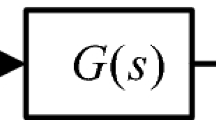Abstract
The present research work proposes a new systematic approach to the problem of model-reduction for nonlinear dynamical systems. The formulation of the problem is conveniently realized through a system of singular first-order quasi-linear invariance partial differential equations (PDEs), and a rather general explicit set of conditions for solvability is derived. In particular, within the class of analytic solutions, the aforementioned set of conditions guarantees the existence and uniqueness of a locally analytic solution. The solution to the above system of singular PDEs is then proven to represent the slow invariant manifold of the nonlinear dynamical system under consideration exponentially attracting all dynamic trajectories. As a result, an exact reduced-order model for the nonlinear system dynamics is obtained through the restriction of the original system dynamics on the aforementioned slow manifold. The local analyticity property of the solution’s graph that corresponds to the system’s slow manifold enables the development of a series solution method, which allows the polynomial approximation of the system dynamics on the slow manifold up to the desired degree of accuracy and can be easily implemented with the aid of a symbolic software package such as MAPLE. Finally, the proposed approach and method is evaluated through an illustrative biological reactor example.
Similar content being viewed by others
References
Arnold, V.I.: Geometrical Methods in the Theory of Ordinary Differential Equations. Springer, New York (1983)
Astolfi, A., Ortega, R.: Immersion and invariance: A new tool for stabilization and adaptive control of nonlinear systems. IEEE Trans. Automat. Contr. 48, 590 (2003)
Bykov, V., Goldfarb, I., Gol’dshtein, V., Maas, U.: On a modified version of ILDM approach: Asymptotic analysis based on integral manifolds. IMA J. Appl. Math. 71, 359 (2006)
Chiavazzo, E., Gorban, A.N., Karlin, I.V.: Comparison of invariant manifolds for model reduction in chemical kinetics. Commun. Comput. Phys. 2, 964 (2007)
Courant, R., Hilbert, D.: Methods of Mathematical Physics, vol. II. Wiley, New York (1962)
Cox, S.M., Roberts, A.J.: Initial conditions for models of dynamical systems. Physica D 85, 126 (1995)
Evans, L.C.: Partial Differential Equations. American Mathematical Society, Providence (1998)
Foias, C., Sell, R., Titi, E.S.: Exponential tracking and approximation of inertial manifolds for dissipative equations. J. Dyn. Differ. Equ. 1, 199 (1989)
Gantmacher, F.R.: The Theory of Matrices. Chelsea, New York (1960)
Gorban, A.N., Karlin, I.V.: Methods of invariant manifolds and regularization of acoustic spectra. Trans. Theor. Stat. Phys. 23, 559 (1994)
Gorban, A.N., Karlin, I.V., Zmievskii, V.B., Dymova, S.V.: Reduced description in the reaction kinetics. Physica A 275, 361 (2000)
Gorban, A.N., Karlin, I.V.: Method of invariant manifold for chemical kinetics. Chem. Eng. Sci. 58, 4751 (2003)
Gorban, A.N., Karlin, I.V., Zinovyev, A.Y.: Constructive methods of invariant manifolds for kinetic problems. Phys. Rep. 396, 197 (2004)
Gorban, A.N., Karlin, I.V.: Invariant Manifolds for Physical and Chemical Kinetics. Lecture Notes in Physics, vol. 660. Springer, Heidelberg (2005)
Guckenheimer, J., Holmes, P.J.: Nonlinear Oscillations, Dynamical Systems, and Bifurcations of Vector Fields. Springer, New York (1983)
Jin, S., Slemrod, M.: Regularization of the Burnett equations for rapid granular flows via relaxation. Physica D 150, 207 (2001)
Kaper, T., Koppel, N., Jones, C.K.R.T.: Tracking invariant manifolds up to exponentially small errors. SIAM J. Math. Anal. 27, 558 (1996)
Kazantzis, N.: Singular PDEs and the problem of finding invariant manifolds for nonlinear dynamical systems. Phys. Lett. A 272, 257 (2000)
Kazantzis, N., Good, T.: Invariant manifolds and the calculation of the long-term asymptotic response of nonlinear processes using singular PDEs. Comput. Chem. Eng. 26, 999 (2002)
Kokotovic, P.V., Khalil, H.K., O’Reilly, J.O.: Singular Perturbation Methods in Control: Analysis and Design. Academic Press, San Diego (1986)
Lam, S.H., Goussis, D.A.: The CSP method for simplifying kinetics. Int. J. Chem. Kinet. 26, 461 (1994)
Li, G., Rabitz, H.: A general analysis of exact nonlinear lumping in chemical kinetics. Chem. Eng. Sci. 49, 343 (1994)
Lyapunov, A.M.: The General Problem of the Stability of Motion. Taylor & Francis, London (1992)
Maas, U., Pope, S.B.: Simplifying chemical kinetics: Intrinsic low-dimensional manifolds in composition space. Combust. Flame 88, 239 (1992)
MacKay, R.S.: Slow manifolds. In: Dauxois, T., Litvak-Hinenzon, A., MacKay, R.S., Spanoudaki (eds.) Energy Localisation and Transfer, p. 149. World Scientific, Singapore (2004)
Moore, G.: Geometric methods for computing invariant manifolds. Appl. Numer. Math. 17, 319 (1995)
Roberts, A.J.: Low-dimensional modelling of dynamics via computer algebra. Comput. Phys. Commun. 100, 215 (1997)
Roussel, M.: Forced-convergence iterative schemes for the approximation of invariant manifolds. J. Math. Chem. 21, 385 (1997)
Roussel, M., Fraser, S.J.: Invariant manifold methods for metabolic model reduction. Chaos 11, 196 (2001)
Vora, N., Contou-Carrere, M.N., Daoutidis, P.: Model reduction of multiple time-scale processes in non-standard singularly perturbed form. In: Gorban, A.N., (eds.) Coarse Graining and Model Reduction Approaches for Multiscale Phenomena. Lecture Note Series in Complexity. Springer, Berlin (2006)
Wiggins, S.: Introduction to Applied Nonlinear Dynamical Systems and Chaos. Springer, New York (1990)
Zagaris, A., Kaper, H.G., Kaper, T.J.: Analysis of the computational singular perturbation reduction method for chemical kinetics. J. Nonlinear Sci. 14, 59 (2004)
Zmievski, V.B., Karlin, I.V., Deville, M.: The universal limit in dynamics of dilute polymeric solutions. Physica A 275, 152 (2000)
Author information
Authors and Affiliations
Corresponding author
Rights and permissions
About this article
Cite this article
Kazantzis, N., Kravaris, C. & Syrou, L. A new model reduction method for nonlinear dynamical systems. Nonlinear Dyn 59, 183–194 (2010). https://doi.org/10.1007/s11071-009-9531-y
Received:
Accepted:
Published:
Issue Date:
DOI: https://doi.org/10.1007/s11071-009-9531-y




